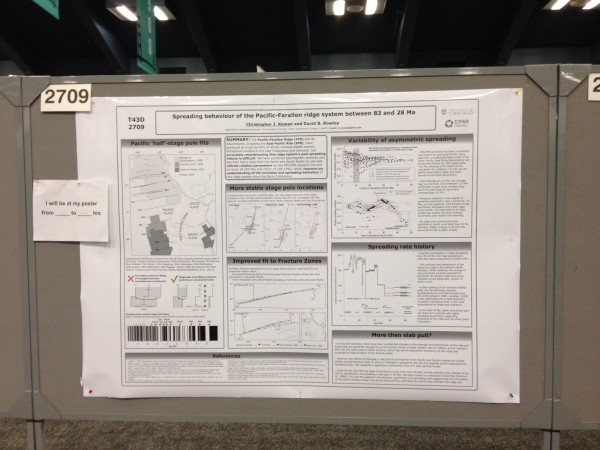![]() Another packed day, although for me, today was less about consuming science and more about both disseminating it, and learning how to teach about it. Nonetheless, I kicked off my morning in an interesting session on the links between short-term and long-term deformation. Two talks addressed one of the more urgent questions in seismic hazard research: what, if anything, controls where destructive, tsunami-generating great earthquakes occur at subduction zones. Sara Carena and Dietmar Muller gave back-to-back presentations that implicated places where old oceanic fracture zones where being subducted as places where great earthquakes were likely to nucleate. Muller’s global analysis – using an algorithm related to the one that powers Amazon’s recommendation system, believe it or not – placed 90% of recorded great earthquakes within 150 km of a subducted fracture zone. Carena suggested that fracture zones, once subducted, act as lateral ramps on the megathrust, and their high mechanical strength makes them likely nucleation points for larger earthquakes, accommodating a lot of elastic strain build up before they fail. The only caveat to this is that these analyses are based on our limited record of great earthquakes; and these sort of relationships have been found in the past, only to break down with the addition of more data.
Another packed day, although for me, today was less about consuming science and more about both disseminating it, and learning how to teach about it. Nonetheless, I kicked off my morning in an interesting session on the links between short-term and long-term deformation. Two talks addressed one of the more urgent questions in seismic hazard research: what, if anything, controls where destructive, tsunami-generating great earthquakes occur at subduction zones. Sara Carena and Dietmar Muller gave back-to-back presentations that implicated places where old oceanic fracture zones where being subducted as places where great earthquakes were likely to nucleate. Muller’s global analysis – using an algorithm related to the one that powers Amazon’s recommendation system, believe it or not – placed 90% of recorded great earthquakes within 150 km of a subducted fracture zone. Carena suggested that fracture zones, once subducted, act as lateral ramps on the megathrust, and their high mechanical strength makes them likely nucleation points for larger earthquakes, accommodating a lot of elastic strain build up before they fail. The only caveat to this is that these analyses are based on our limited record of great earthquakes; and these sort of relationships have been found in the past, only to break down with the addition of more data.
Just before lunch, I also made a rare excursion to Moscone West (which, back when I first attended AGU, was conference hall enough for all of us, which shows how much things have grown in the last decade) to hear Tim Wright discuss the strength of the continental crust. A debate over exactly where the strength in the crust lies has kicked off a bit in recent years, mainly based on earthquake data, but Tim added geodetic constraints into the mix. From his analysis, it seems that those who have pushed the ‘creme brulee’ model (where the upper crust forms a strong rind on a weaker lower crust) at the expense of the venerable ‘jelly sandwich’ model (where a strong upper and lower crust bracket a weak layer in the middle) might be on to something.
In between, I was in the poster hall vortex, exploring the aisles assigned to the Education section. My change of job naturally makes this a subject of much more urgent interest to me: in other words, I was trawling for ideas to make my lessons more relevant, interesting and understandable. One fairly pervasive theme which I liked very much (and was also highlighted in some talks I went to right after lunch) was the clear push to utilise all of the wonderful geological and geophysical datasets – seismic, GPS, LIDAR, and many more – becoming available online as teaching resources, with time also being devoted to developing clear lesson plans and practical exercises. I think some of them will be very useful in my classes next year.
I also browsed the paleomagnetism posters, and had the agreeably bizarre experience of stopping by a poster because it was on a subject I’d published on in the past, only to find that it extensively cited and was building on my work. I guess this means I’m a grown up scientist now? I had a nice chat with the author, Alejandra Dominguez, who is working on her undergraduate thesis and handled the ‘Aarggh! The person I’ve cited is standing in front of my poster!’ moment with good grace.
Most of my afternoon was, of course, devoted to manning my poster on the spreading history of the Pacific and Farallon plates (for those who are interested, the ePoster is currently available on the AGU Meeting site)
I’ve come to the conclusion that whilst talks at large meetings like AGU are generally thought to be more prestigious, they are more for when you want to advertise your work; if you actually want to discuss it, then in front of a poster is in many ways a better venue. I certainly got a lot of discussion, to the extent that my voice was feeling a little hoarse at the end of my stint. Not only did I get mostly positive comments and some good ideas for further work, but I also met a few online pals in the flesh for the first time, including Alex Witze (the Carl Zimmer of Earth Science reporting) and Rob Simmon, who is responsible for all the wonderful imagery produced by NASA’s Earth Observatory.
A good but tiring day, then. Only one more to go!




Nice plan for content warnings on Mastodon and the Fediverse. Now you need a Mastodon/Fediverse button on this blog.